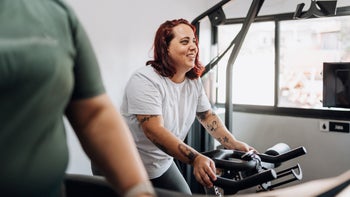
8 Proven Health Benefits of Rock Climbing
Key takeaways:
Rock climbing is an increasingly popular full-body workout that involves scaling outdoor rock formations or indoor rock climbing walls.
There are many science-backed benefits of rock climbing, including better grip strength, hand-eye coordination, and flexibility.
The best way to get started is at a rock climbing gym, where you can make sure you enjoy the workout before investing in any gear.
Table of contents

Rock climbing isn’t just a fun hobby for adventurous athletes (although it certainly is that, too). It can also be good for your body and mind. The benefits of rock climbing — such as better grip strength and mental well-being — make it an effective workout for beginners and experienced climbers alike.
Learn more about the benefits of this full-body workout and how to get started.
What are the benefits of rock climbing?
As the name implies, rock climbing involves using your body to travel up, down, and across rock formations. You can do it outside or in a gym with rock climbing walls. The goal is usually to reach a summit or other predetermined endpoint on a climbing route.
Search and compare options
Whatever type of rock climbing you do, you can look forward to a host of physical and mental health benefits. Here are eight to consider.
1. Builds total-body strength
You might think rock climbing is all about pulling yourself up. But you use muscles all over your body to climb. You pull up with your arms, push up with your legs, and engage your core to stay in place between hand or footholds while climbing. This can strengthen several muscles, especially the following:
Shoulders (deltoids and rotator cuff muscles)
Arms (biceps and forearm flexors)
Back (latissimus dorsi and trapezius in the upper back)
Hip flexors
Legs (glutes, quadriceps, and calves)
Core (abdominals and erector spinae in the back)
Hands and feet
The more you do it, the stronger you’ll get. More strength can improve your performance in rock climbing and other sports. For example, a review found that rock climbing helped college students improve leg muscle power and vertical jump height. It also increased the number of push-ups and pull-ups they could do.
2. Improves grip strength
According to the same review, rock climbing may also increase grip strength. Grip strength is the force of your forearm, hand, and wrist muscles used to hold onto something. In another study, young adults did an indoor climbing program. After 8 weeks, they had better handgrip and core strength.
That’s a good thing, as handgrip strength is important for more than tasks like opening a jar of salsa. Research suggests that handgrip strength is linked to longevity and a lower risk of heart disease.
Not ready for rock climbing? Start with stair climbing sessions first. Learn the benefits of stair climbing and how to get started.
Build your grip strength. A strong grip can help with rock climbing and daily activities. And it’s been linked to better health. Try these grip-strengthening exercises.
Recover from rock climbing with yoga. Gentle yoga poses that lengthen your muscles can increase flexibility.
3. Burns calories
Rock climbing helps you burn calories. But calorie burn depends on your body weight, exercise intensity, and other factors. An older study found that rock climbing burned roughly the same calories as running at a moderate pace of 8 to 11 minutes per mile. By some estimates, you could burn up to 950 calories per hour of climbing.
This means rock climbing can be good for weight loss, if that’s your goal. Just make sure you’re also eating a balanced diet, varying your fitness routine, and leaving plenty of time for rest and recovery.
4. Improves cardiorespiratory fitness
The same older study found that climbers’ heart rates increased to about 74% to 85% of their maximum heart rate during a climbing workout. That’s high enough to be considered vigorous exercise.
Read more like this
Explore these related articles, suggested for readers like you.
Intense exercise is one of the best ways to increase VO₂ max. Your VO₂ max measures cardiorespiratory fitness, or how much oxygen your body uses for energy during exercise. The higher your VO₂ max, the fitter you (generally) are.
5. Increases flexibility
Reaching and stretching as you climb can increase your flexibility. A small, older study found that elite rock climbers had greater hip flexibility than casual climbers and people who didn’t climb. Flexibility allows you to move your joints through their full range of motion without pain. That’s critical for functional mobility and athletic performance.
6. Supports strong bones
Weight-bearing exercises like rock climbing can help you build and maintain strong bones. In a small study, rock climbers had similar bone density in their arms and legs as people who regularly strength trained. People who didn’t exercise at all had lower scores.
Bone density is a measure of certain minerals in your bones that make them less likely to break. Regular exercise — including weight-bearing moves, strength training, and balance training — can strengthen bones and lower the risk of osteoporosis.
7. Improves hand-eye coordination
Hand-eye coordination is the way your brain processes visual input from your eyes to coordinate movement with your hands and arms. Rock climbing is a great example of hand-eye coordination: You see the perfect jug on the climbing wall above you, and your hand reaches for it within seconds. Climbing both requires a lot of coordination and helps enhance coordination the more you do it.
8. Relieves stress
Rock climbing requires your full attention. After all, you don’t want to fall. When you’re present in the moment during a workout, you can become more mindful. Mindfulness can help ease stress, anxiety, and depression over time.
A 2021 study found people rated their mindfulness higher after climbing than after strength training. Some early research suggests climbing might be a helpful tool for treating mental health conditions (alongside more traditional forms of treatment like therapy and medication).
Are there different types of rock climbing?
There are many types of rock climbing. Here are common types you might try:
Aid climbing: Climbers use equipment attached to the rock to help move up the formation or wall. Aid climbing is the opposite of free climbing.
Free climbing: Climbers only use their hands and feet to propel upward. They still use ropes for protection but not for assistance. Free climbing is the opposite of aid climbing.
Traditional climbing: The first climber places bolts (to hold ropes) into the rock as they progress. The second (or final) climber then removes the equipment as they follow. Also called trad climbing, this is the opposite of sport climbing.
Sport climbing: Climbers use bolts and ropes that are already in place. This is the form of climbing you’ll see in the Olympics, and it’s the opposite of traditional climbing.
How do you get started rock climbing?
Ready to reap the benefits of rock climbing? It’s a good idea to start with an introductory class for beginners at a local climbing gym. From there, you can progress slowly, starting with 1 or 2 weekly rock climbing workouts and building up to as many as 5. If you get started in a climbing gym, make sure to wear comfortable workout clothes. The facility will usually provide all other climbing gear you’ll need, including:
Climbing shoes
Chalk
Harness
Helmet
The bottom line
Rock climbing is a full-body strength and cardio workout that can help you build head-to-toe muscle strength, lower stress, and protect your bones, among other health benefits. Beginners can start at a rock climbing gym. Professional instructors can introduce you to basic techniques, essential gear, and safety equipment.
If you enjoy rock climbing and plan to stick with it, consider investing in your own gear. You may also want to try climbing outside as you continue to improve your grip strength, flexibility, and hand-eye coordination.
Why trust our experts?



References
American Heart Association. (2021). Target heart rates chart.
Chang, C., et al. (2022). Regular exercise decreases the risk of osteoporosis in postmenopausal women. Frontiers in Public Health.
Frühauf A., et al. (2021). Expert views on therapeutic climbing–a multi-perspective, qualitative study. International Journal of Environmental Research and Public Health.
Grant, S., et al. (1996). Anthropometric, strength, endurance and flexibility characteristics of elite and recreational climbers. Journal of Sports Sciences.
Griffith, K. (2022). Getting started rock climbing. REI.
Leong, D. P., et al. (2015). Prognostic value of grip strength: findings from the Prospective Urban Rural Epidemiology (PURE) study. The Lancet.
Li L., et al. (2018). Effects of rock climbing exercise on physical fitness among college students: A review article and meta-analysis. Iranian Journal of Public Health.
Luttenberger, K., et al. (2015). Indoor rock climbing (bouldering) as a new treatment for depression: study design of a waitlist-controlled randomized group pilot study and the first results. BMC Psychiatry.
MedlinePlus. (n.d.). Bone density.
Mermier, C. M., et al. (1997). Energy expenditure and physiological responses during indoor rock climbing. British Journal of Sports Medicine.
Muehlbauer T., et al. (2012). Effects of climbing on core strength and mobility in adults. International Journal of Sports Medicine.
National Institute of Arthritis and Musculoskeletal and Skin Diseases. (2023). Exercise for your bone health.
National Park Service. (2021). Types of climbing.
REI. (n.d.). Rock climbing glossary.
Sheel, A. W. (2004). Physiology of sport rock climbing. British Journal of Sports Medicine.
Sherk, V. D., et al. (2010). Comparisons of bone mineral density and bone quality in adult rock climbers, resistance-trained men, and untrained men. Journal of Strength and Conditioning Research.
Wheatley, K. A. (2023). Exploring the relationship between mindfulness and rock-climbing: a controlled study. Current Psychology.
Wisconsin Department of Health Services Division of Public Health. (2005). Calories burned per hour.



























